Scientific name: Pinus edulis Engelm.
Synonym: P. cembroides var. edulis (Engelm.) Voss
Suggested pronunciation: PY-nus Ed-yew-liss
Common names: piñon pine, pinyon pine, two-needle pinyon, Colorado pinyon, American pinon, piñon
Family: Pinaceae
Article by Jeanne Gozigian
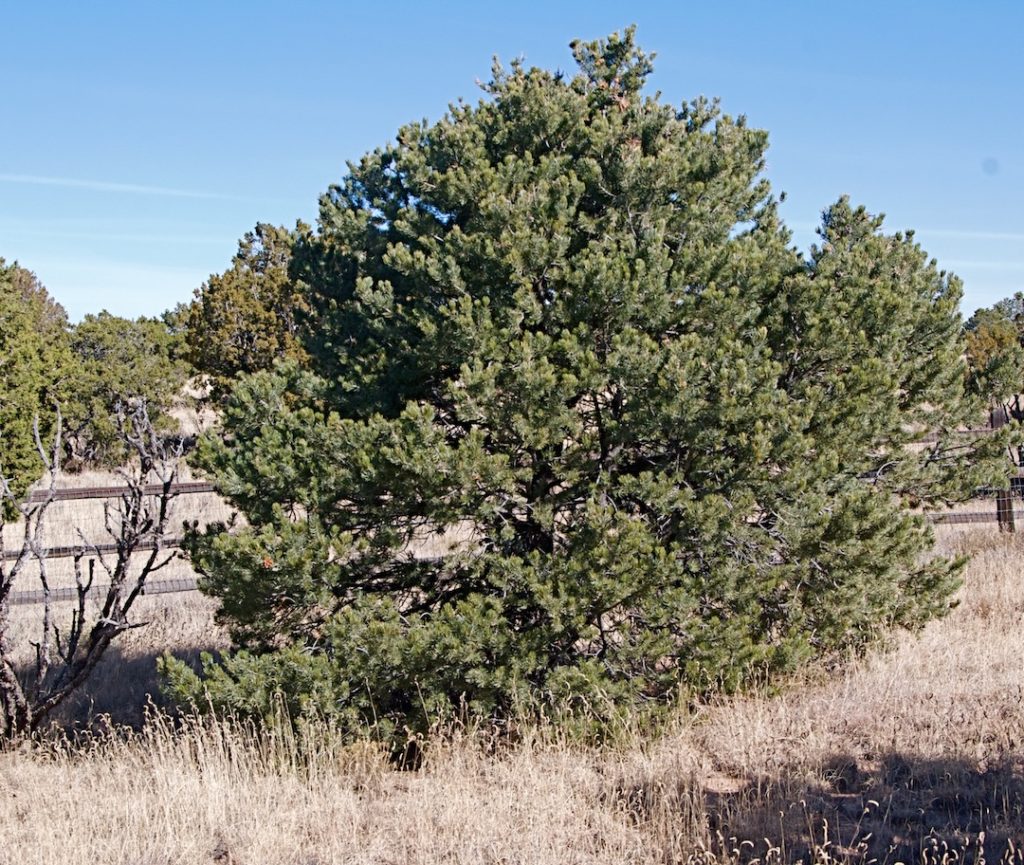
Piñon in natural setting. It gets no supplemental water. Photo by Janice Tucker.
The piñon pine, (Pinus edulis), is the state tree of New Mexico. When I first moved here in August 1989, from upstate New York, that first fall I wondered at the many numbers of cars pulled to the sides of the roads, even busy interstates. It appeared that large family groups were gathering something beneath bushy, smallish, different-looking pine trees. I soon learned that these were piñon trees; they were, seemingly, everywhere and the edible nuts were important, delicious ingredients in many dishes of southwest cuisine.
The trees grow extensively in the American southwest, especially New Mexico, Arizona, Colorado and Utah. They derived their name from the Spanish, pinopionero, for both the American piñon and the stone pine of Spain. Pine nuts figure prominently in Mediterranean cuisine as well.
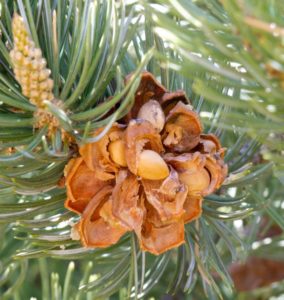
Piñon cone with seeds. Photo by Janice Tucker.
Piñon nuts are very high in fats and calories so became important snacks and foods for indigenous peoples and early settlers. The nuts possess numerous phytochemicals, vitamins and antioxidants.
It is believed that since the arrival of Homo sapiens in Oasisamerica, the Great Basin and American southwest, the early humans were harvesting piñon nuts after the last ice age, roughly from 4,000 BCE to 600 CE. Reliance on this crucial nutrient supply as a staple in their diets was hampered by the unreliability of harvests. Good crops came every four to six years, with spotty ones between two and seven years. The slow growing trees take three years to mature, so people learned to store piñons in pits.
Pinus edulis is Latin for “edible pine.” Their main trunks, with gray or red-brown fissured bark, support rounded, dark green, open, airy foliage (needles). They can attain 10-35 feet in height and trunks can be two feet in diameter. The cones are 1.5 – 2 inches in length, holding 10-20 soft-shelled seeds – they are botanically seeds, not nuts, luckily for people with lethal nut allergies, like my grandson, Sam! The trees tend to drop lower limbs as they age. They can live as long as 800 years in their preferred semi-desert, foothills and woodland locations. That is, unless there is severe drought as there was in the early 2000s. It was combined with the piñon ips beetle (Ips confusus) infestation that killed millions of piñons. We had over 600 trees removed from our 10 acre lot, and we watered extensively to save our most treasured specimens. Hoses were strung up and down the hill, to little avail. So went our wooded lot!
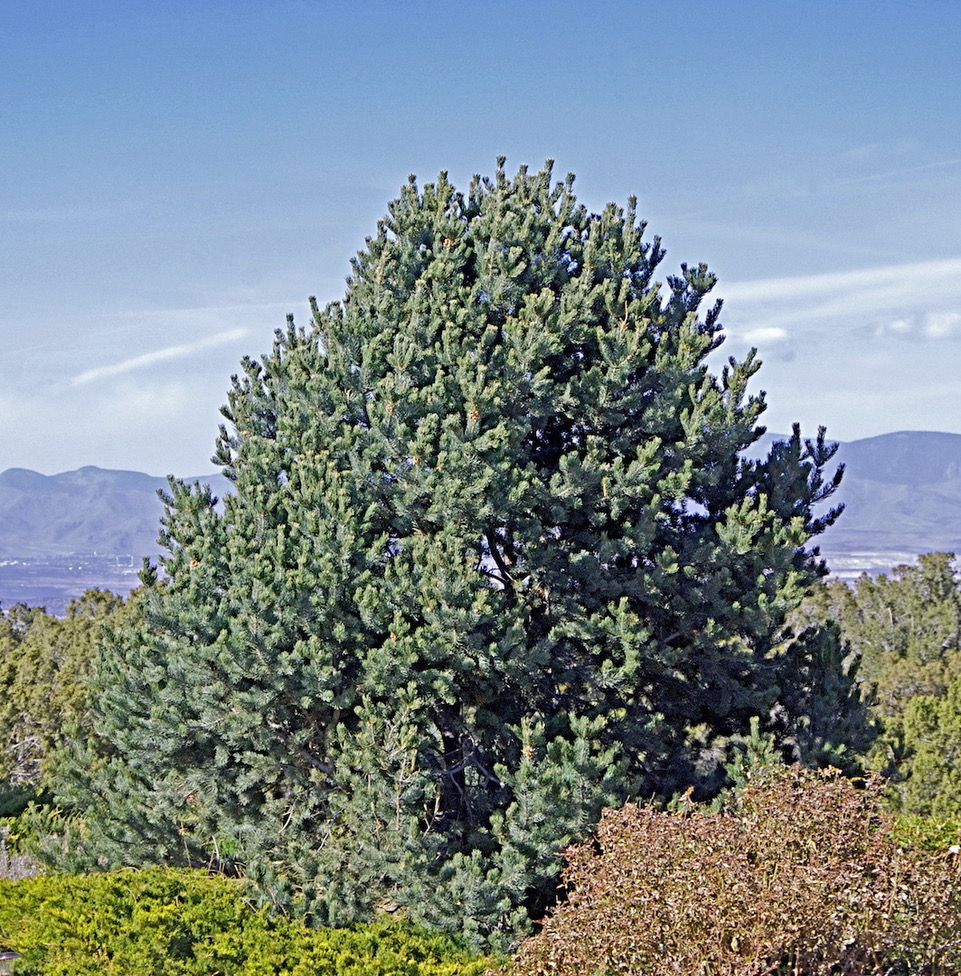
Piñon tree in Santa Fe that receives supplemental irrigation. Photo by Janice Tucker.
Pinus edulis was first collected by German-born American doctor/botanist (1810-1889) Friedrich Wislizenus in the Sangre de Cristo Range of New Mexico and first described by German-American botanist George Engelmann (1809-1884) in Wislizenus’ Tour Through Northern Mexico. They are generally monoecious, with male and female reproductive parts on the same tree. Pollen is carried for miles on the wind. Seed dispersal is mostly by birds and small mammals, like squirrels and chipmunks. The seeds prefer to germinate in the shade of trees and shrubs. Woodhouse scrub-jays cache large numbers of seeds, so are very important in two-needle pinyon regeneration. On August 28, 2018, the U.S. Forest Service’s Fire Effects Information System (FEIS) changed the common name in their database from Colorado pinyon to two-needle (or twoneedle) pinyon.
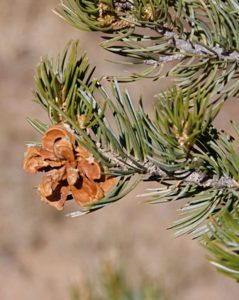
Piñon and juniper forests dominate hundreds of thousands of acres on the Colorado Plateau at 4,000-8,000 feet of elevation. Piñon pine (Pinus edulis), Utah juniper (Juniperus osteosperma) and one-seed juniper (Juniperus monosperma) were the trees around which ancient Anasazi life revolved. These trees were used to build their shelters and feed, clothe and warm them. The Santa Fe Botanical Garden at Museum Hill, in Santa Fe, New Mexico, will soon open trails through an area adjacent to the gardens for visitors to experience a piñon-juniper woodland area.
Piñon trees continue to have many uses for people today. As firewood, it is pleasantly aromatic, clean burning and easily lit, leaving little smoke and ash. The smoke repels mosquitos and other insects. The nuts are valued for their culinary and nutritional properties. They are high in protein and monounsaturated fatty acids that help lower LDL “bad cholesterol” in blood. The flavor is buttery, mild and sweet, with tones of citrus. Here is a recipe for the sweet lovers in your house:
Piñon Mexican Wedding Cookies – makes 40
Ingredients: preheat oven to 325 degrees (170 C)
- 1 cup (135 grams) shelled pine nuts, toasted
- 2/3 cup (80 grams) confectioners’ sugar, divided
- 1 cup (227 grams) unsalted butter, softened
- 1 tsp. (4 grams) vanilla extract
- 2 cups (250 grams) all-purpose flour
- ½ tsp. (one gram) ground cinnamon
- ¼ tsp. kosher salt
- Garnish: confectioner’s sugar
- Line 2 cookie sheets with parchment paper.
- Process pine nuts and 1/3 cup sugar until finely ground.
- In stand mixer, beat butter and remaining sugar until fluffy. Add vanilla.
- Gradually add nut mixture, flour, cinnamon and salt to combine.
- Roll one tablespoon portions of batter into balls, chill 15 minutes, and place 1 inch apart on sheets.
- Bake for 12-15 minutes or until golden but pale on top. Cool completely. Dust with confectioner’s. sugar. Store in air-tight container up to 5 days.
- Enjoy!
Navajo families advise that you pick up seeds that have naturally fallen; do not hit the trees to aid the fall. Look for the darker ones, clean the nuts with baking soda, then roast the nuts in an iron skillet.
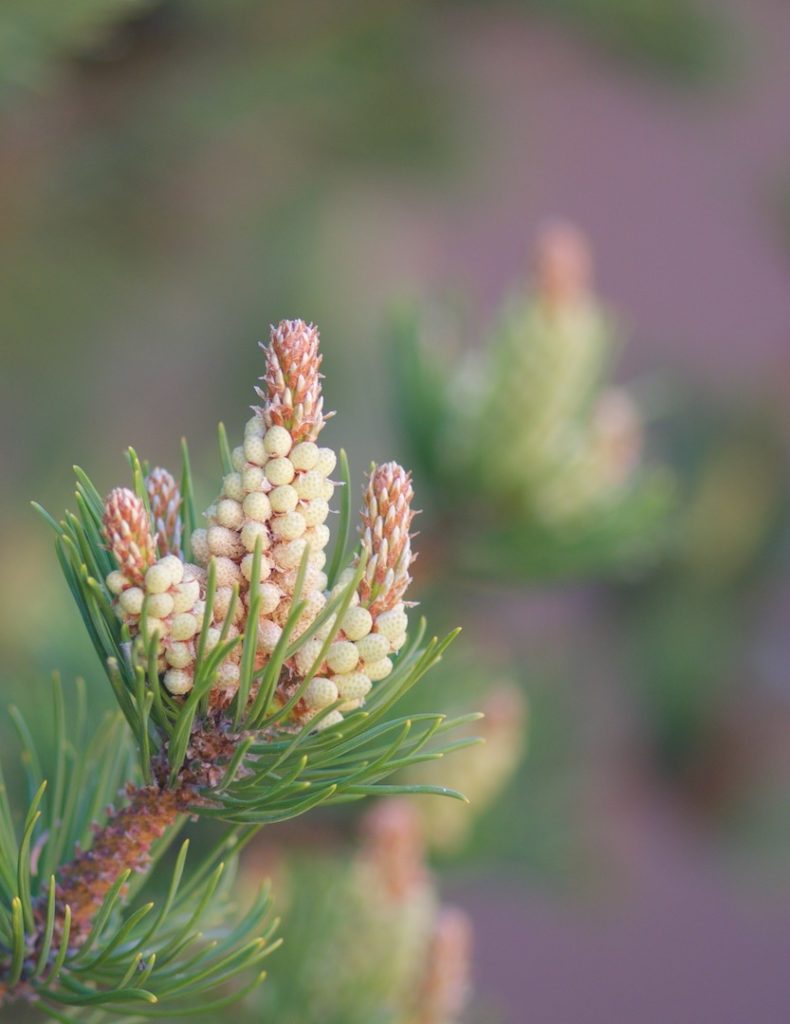
Young pine cones. Photo by Janice Tucker.
The volatile oils in members of the Pinaceae family are one of the reasons why humans are so attracted to this plant family. We have mentioned the aroma of burning piñon. In addition, we have found uses for piñon pine essential oils. They are usually attained by steam distilling, using needles and twigs. They have crisp, fresh scents that blend well with those from mint, wood and citrus families. Aroma therapists believe that these oils can be calming, energizing and promote focusing. Warnings state that they should be diluted, not used topically if oxidized, not taken internally and never used on children. It is recommended that one consult Essential Oil Safety: A Guide for Health Care Professionals, by Robert Tisserand, one of the world’s leading experts in aromatherapy, if contemplating usage.
Pinus edulis is a nice addition to a Santa Fe or southwest garden, always green and very drought tolerant, happy in semi-arid, warm climates, and colder, semi-arid mountainous areas. All types of soil are tolerated – shallow, rocky and with low fertility, but well drained. Be warned that they have very deep tap roots and wide lateral roots that discourage understory growth. Buy your small tree from a good nursery. I learned the hard way that attempts to transplant even tiny trees ended in failure!
Thanks to Janice Tucker and Helen Woody for proofreading this article.
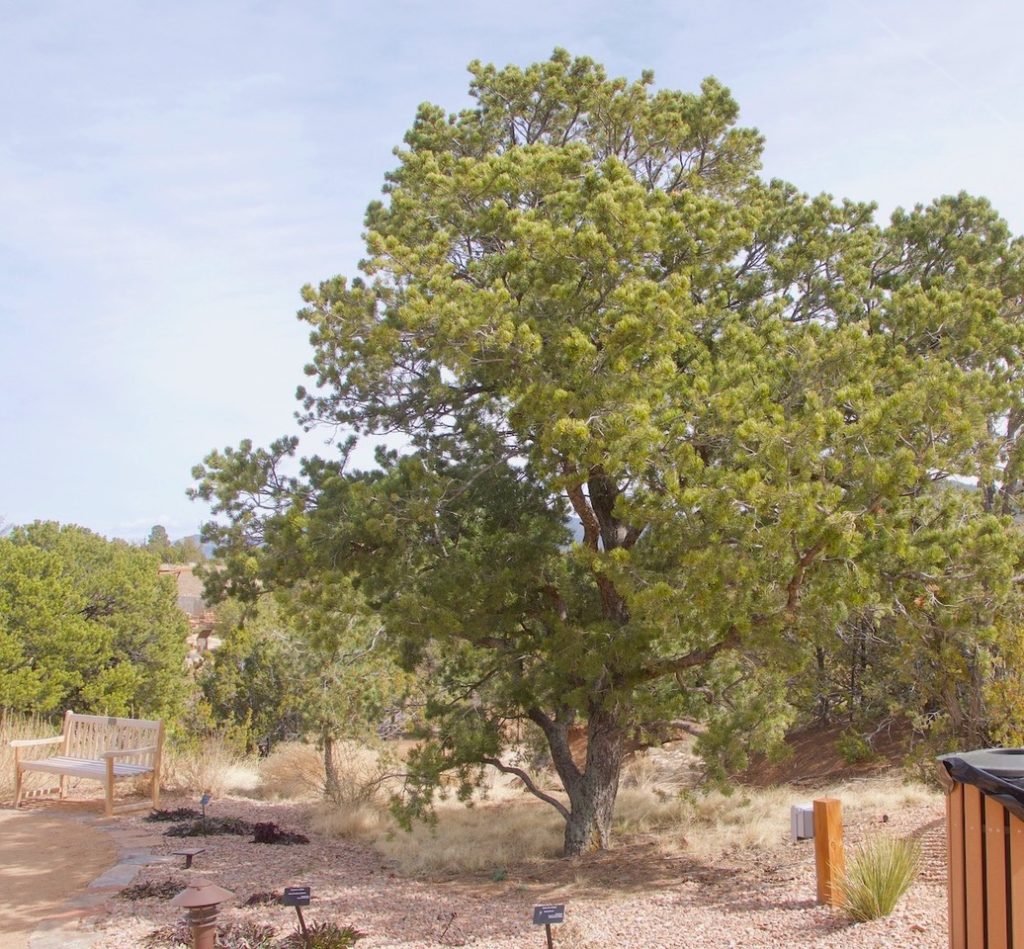
Piñon at Botanical Garden at Museum Hill. Photo by Janice Tucker.
Sources consulted
“Piñon Pine, New Mexico State Tree”. State Symbols USA. Web. 1948. 20 Jan 2021 Retrieved from: https://statesymbolsusa.org/symbol-official-item/new-mexico/state-tree/piñon-pine.
“Pinus edulis/piñon pine”. American Conifer Society. Web. Retrieved from: conifersociety.org/conifers/pinus-edulis.
“Pinus edulis”. USDA, NRCS. 2021. The PLANTS Database (http://plants.usda.gov, 22 January 2021). National Plant Data Team, Greensboro, NC 27401-4901 USA. 22 Jan 2021. Retrieved from: https://www.fs.fed.us/database/feis/plants/tree/pinedu/all.html.
“Pinyon Pine- Pinus edulis”. Urban Forest Ecosystems Institute. SelecTree: Tree Detail. Web.27 Jan 2021. Retrieved from: selectree.calpoly.edu/tree-detail/pinus-edulis.
“Pinyon Pine Essential Oil – Uses and Benefits.” AromaWeb. Web. 2021. 22 Jan 2021. Retrieved from: www.aromaweb.com/essential-oils/pinyon-pine-oil.asp.
“Pinyon Pine, Native Nut Trees for Sale” Native Foods Nursery. 2021. Web. 20 Jan. 2021. Retrieved from: nativefoodsnursery.com/pinyon-pine
Schneider, Al. “Pinyon and Juniper Forests”. Southwest Colorado Wildflowers. Web. 20 Jul 2020. 25 Jan 2020. Retrieved from:
http://www.swcoloradowildflowers.com/Tree%20Enlarged%20Photo%20Pages/pinus%20edulis.htm.
“Using and Eating Piñon Pine”. Mother Earth News. Web. 21 Apr 2014. 27 Jan 2021. Retrieved from: https://www.motherearthnews.com/natural-health/herbal-remedies/eating-pinon-pine-ze0z1404zjhar.
Dyer, Mary H. “ Pinon Nut Information – Where Do Pinon Nuts Come From”. Gardening Know How. Web. 2021. 24 Jan 2021. Retrieved from: https://www.gardeningknowhow.com/edible/nut-trees/pine-nut/pinon-nut-information.htm.
“Why New Mexico Piñon Firewood?” Indian Head Firewood. Web. 2019. Retrieved from: https://www.indianheadfirewood.com/why-pinion-wood/.
“Pinyon Pine”. Wikipedia. Web. 20 Dec 2020. 10 Jan 2021. Retrieved from: https://en.wikipedia.org/wiki/Pinyon_pine.


